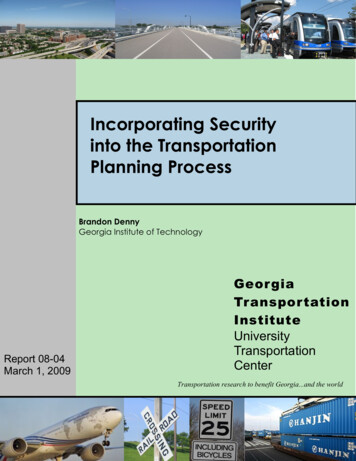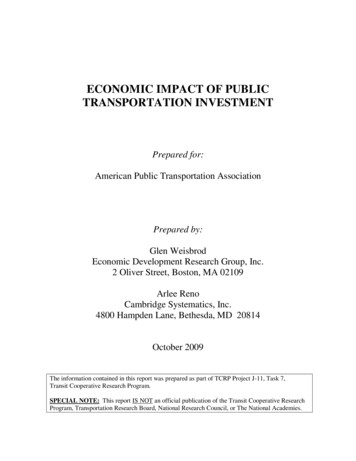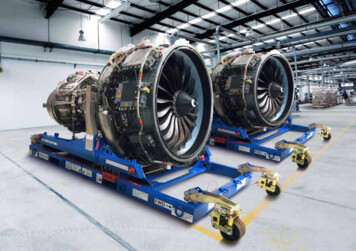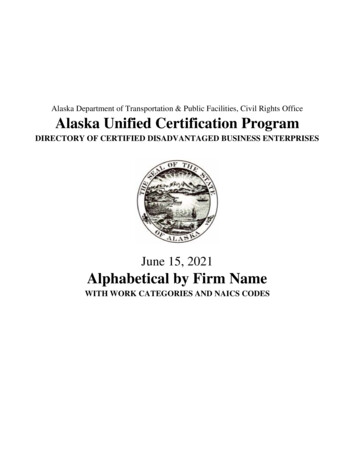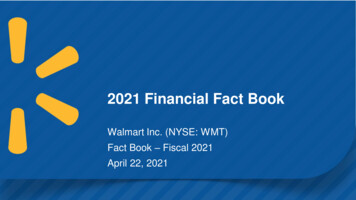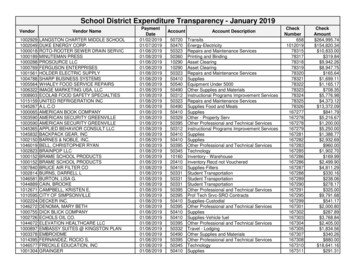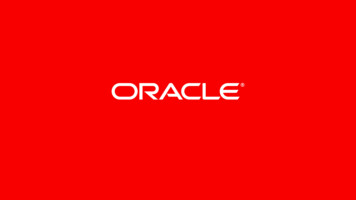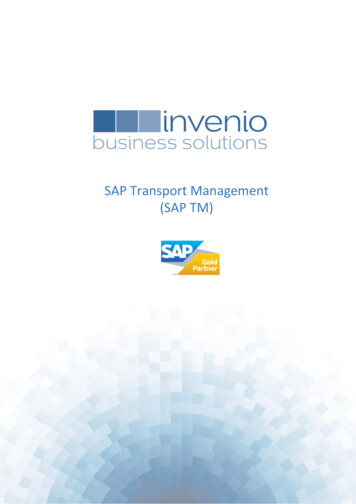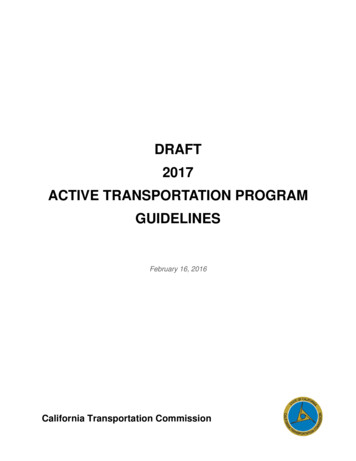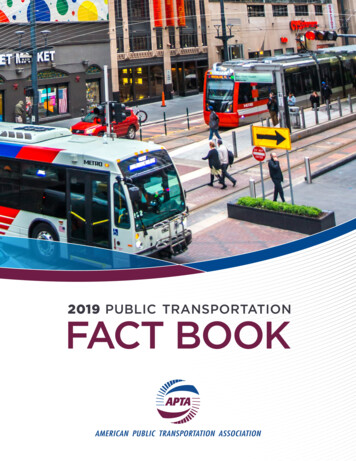
Transcription
2019 PUBLIC TRANSPORTATIONFACT BOOK
2019 PUBLIC TRANSPORTATIONFACT BOOK70th EditionApril 2019APTA’s Purpose StatementAPTA leads publictransportation in a newmobility era, advocatingto connect and buildthriving communities.II APTA
CONTENTS2Today, Public Transit in America is 21SafetyTotal Transit Related Fatalities and Accidents4National Totals Table227Total Transit Funding, Passenger Fare Revenue,Average Base Fare, Capital Funding by Source,Operating Funding by SourcePublic Transit System OverviewTotal Number of Systems, Number of ModesOperated, 2016 Rail Openings10Passenger Travel252715Service ProvidedTransit Spending and Contractingin the Private SectorVehicle Revenue Miles Operated, Vehicle RevenueHours Operated, Modal Shares of ServiceEstimated Expenditures in the Private Sector,Revenue Hours ContractedVehiclesVehicles Available for Maximum Service,Vehicle Age by Mode, Vehicle Accessibility,Bus Passenger Equipment, Bus Fuel Type,Total Mechanical Failures, Revenue VehicleMaintenance18Canadian SummaryPassenger Boardings, Total Vehicle Miles,Vehicle Age, Revenue Vehicles, Total Employees30Amtrak SummaryTop 10 Routes by Ridership, Top 15Busiest Stations31Modal RankingsNational Totals for Selected Modes, 50 LargestAgencies, 50 Urbanized Areas with Most TransitTravel, Listing of Largest Agencies by Mode,Listing of Largest Rural Agencies by ModeEmploymentTotal Employees, Employees by Function,Employees by Mode, Transit EmployeeCompensation, Average EmployeeCompensation2028InfrastructureRail Directional Route Miles by Mode, AverageStation Spacing, Passenger Station Amenities,Transit Station Accessibility, Percentage ofSystems with Smart Cards20Capital and Operating ExpensesCapital Expenses, Rolling Stock Expenditures,Capital Facility Expenditures, OperatingExpenses, Comparative Operating CostsAmong ModesUnlinked Passenger Trips by Mode, UnlinkedPassenger Miles by Mode, Average Trip Lengthby Mode, VMT vs. Passenger Mile Growth,Population vs. Ridership Growth, ACS TransitCommuting Statistics13Capital and Operating Funding45APTA and the Fact BookMethodology, about APTA and AppendicesEnergyFossil Fuel Consumption, Rail Vehicle MilesOperated per Kilowatt Hour2019 PUBLIC TRANSPORTATION FACT BOOKAPTA 11
TODAY, PUBLIC TRANSITMORE POPULARMORE COMFORTABLETotal PassengerMiles Traveled1997: 42.4 BILLION2007: 53.4 BILLION2017: 57.0 BILLION81%91%76%SECURITYCAMERASEXTERIORBIKE RACKSAUTOMATED STOPANNOUNCEMENTSof BUSES haveMORE CONVENIENTMORE THANGROWINGSince 1997 2017: 88INCREASE INPOPULATIONGROWTHMORE EFFICIENTPublic transittrips are 48%BY RAILMORE WIDESPREAD9254,500 transit systemspublic transitsystemstransit systems2 APTAURBANIncrease in Vehicle MilesOperated per Kilowatt-Hour overthe Past 30 YearsHEAVY RAIL: 24%LIGHT RAIL/STREETCAR: 33%RECEIVING MOREINVESTMENT1,304RURAL publicSince 1997INCREASE INPUBLIC TRANSITRIDERSHIPMORE BALANCEDBY BUSINCREASE INRAIL RIDERSHIP21%19%47%of BUSES have60%Total Number of Rail Systems1997: 52of BUSES haveNONPROFITTransit Spending in the Private Sector1997: 21.0 BILLION2007: 31.3 BILLION2017: 36.9 BILLION
IN AMERICA IS MOREACCESSIBLEFIXED-ROUTE BUS51% 199399% 2018Share of HandicapAccessible PublicTransit VehiclesLIGHT RAIL41%89%DEMAND RESPONSE19932018LEADING IN CLEANTECHNOLOGYShare of Hybrid Electric Buses2009: 4.9%2018: 20.9%(According to APTA’s 2018 Vehicle Database)LOWERINGCARBON EMISSIONS85%91%20184.1BILLIONGALLONS OFGAS SAVED73%by using publictransportation each year.subway rather than a car(According to ICF international’s“The Broader Connectionbetween Public Transportation,Energy Conservation andGreenhouse Gas Reduction”)LESS CARBON DIOXIDEEMISSIONS by using the(According to FTA’s “Public Transportation’sRole in Responding to Climate Change”)SAVING LIVES83% 1993100% 20181993REDUCINGGASOLINECONSUMPTIONCities with more than 40 annual public transit tripsper person have HALF THE TRAFFIC FATALITY RATEof those with fewer than 20 trips per person2018HEAVY RAILCOMMUTER RAIL32%88%1993DRIVING THEECONOMY87% 4direct impact on thelocal economyevery 1 investedin public transitOF TRIPSON PUBLICTRANSIT have aGENERATEDIN ECONOMICRETURNS forCREATING JOBS430K PEOPLEDIRECTLY WORK FORPUBLIC TRANSPORTATIONAGENCIESMany more jobs are supported by theindustry. Each 1 billion investmentin public transit supports 50,000 jobsand 642 million in tax revenue(According to APTA’s “Economic Impact of PublicTransportation Investment”)(According to APTA’s “The Hidden Traffic Safety Report: Public Transportation”)2019 PUBLIC TRANSPORTATION FACT BOOK 3
National Totals for Selected Modes, Report Year 2017 (a)Statistical CategoryBusDemandResponseSystems, Number ofTrips, Unlinked Passenger (Millions)Miles, Passenger (Millions)Trip Length, Average Miles, Vehicle Total (Millions)Miles, Vehicle Revenue (Millions)Hours, Vehicle Total (Millions)Hours, Vehicle Revenue (Millions)Speed, Vehicle in Revenue Service, Average .097.115.2Fares Collected, Passengers (Millions)Revenue per Unlinked Trip, Average4,990.01.1373.41.8Expense, Operating Total (Millions)21,813.35,668.1Operating Expense by Object Class:Salaries and Wages (Millions)8,372.91,154.8Fringe Benefits (Millions)6,368.6655.0Services (Millions)1,578.3340.4Materials and Supplies (Millions)2,154.3330.3Utilities (Millions)236.743.4Casualty and Liability (Millions)591.4148.4Purchased Transportation (Millions)2,267.32,946.7Other (Millions)243.749.0Operating Expense by Function Class:Vehicle Operations (Millions)11,165.21,513.4Vehicle Maintenance (Millions)3,784.7330.2Non-Vehicle Maintenance (Millions)1,022.483.0General Administration (Millions)3,573.7794.8Purchased Transportation (Millions)2,267.32,946.7Expense, Capital Total (Millions)Rolling Stock (Millions)Facilities, Guideway, Stations, Admin. Buildings (Millions)Other (Millions)Revenue Vehicles Available for Maximum ServiceRevenue Vehicles Operated at Maximum ServiceEmployees, OperatingEmployees, Vehicle OperationsEmployees, Vehicle MaintenanceEmployees, Non-Vehicle MaintenanceEmployees, General AdministrationEmployees, CapitalDiesel Fuel Consumed (Gallons, Millions)Other Fossil Fuel Consumed (Gallons, Millions)Electricity Consumed (kWh, Millions)4 .62,006.510,602.7125.8385.0228.88.328.8185.6—
(a)(b)Data for all public transportation service, urbanized area and rural.Total figure represents more modes than included in this table.TransitCommuterHeavy RailLight RailStreetcarFerryboatTotal AllVanpoolRailTransit ��930.0——57.645.31.2—603.1437.36,648.62019 PUBLIC TRANSPORTATION FACT BOOKAPTA 55
77 percent of Americansthink public transportationis the backbone of amulti-transit lifestyle.*6 * AccordingAPTAto APTA’s report, “The Transformation of the American Commuter”
Public Transit System OverviewFigure 1: The Majority of TransitSystems are in Rural AreasIn 2017, approximately 6,800 organizationsprovided public transportation through avariety of modes. An estimated 4,580 non-Number of NTD Reporting Transit Systemsprofit providers make up the majority of theseorganizations. Systems operating in urbanizedand rural areas receive grant money from theFederal Transit Administration (FTA) and reportto the National Transit Database (NTD) as full,reduced or rural systems. Of the 2,229 NTDreporting systems, 1,304 were in rural areasand 925 were in urbanized areas (Figure 1) .1925Figure 2 depicts the number of modesoperated by public transit systems, withdemand response making up a slight majority.Demand response services are point-to-pointoperations often used by people withdisabilities or people unable to travel onfixed-route service. Demand response vansmay also substitute for fixed-route service atoff-peak times, such as late at night.Bus rapid transit (BRT) systems offer lowercost options to providing efficient, highcapacity transportation. The FTA defines BRTas a fixed-route system operating at least 50percent of service on a fixed guideway. ElevenBRT systems were operating in 2017, doublethe number from 2010. A total of 47 ferryboatsystems were operating in 2017, five morethan in 2016. There were 1,226 bus systems,including commuter and BRT operatingin 2017.Figure 3 (page 10) shows how the number ofrail systems around the country continues togrow. Of the 88 rail systems now operated bypublic transit agencies, only nine have beenoperating since the 19th century. Comparedwith 1997, there were 17 additional commuter/hybrid rail systems and 20 additional light rail/streetcar systems. Heavy rail systems are1304Rural AreasUrbanized AreasSOURCE: NATIONAL TRANSIT DATABASEFigure 2: The Majority of SystemsOperate Demand Response ServiceNumber of Systems Offering a Mode of 600400200017390RailBusSOURCE: APTA FACT BOOK ANALYSISUrbanized areas are defined as areas with over 50,000in population.1DemandResponseOther ** Consists of trolleybus, vanpool, ferryboatand other fixed guideway modes2019 PUBLIC TRANSPORTATION FACT BOOKAPTA 77
45403530252015105SOURCE: APTA FACT BOOK ANALYSISFigure 4: New Rail and BRT Infrastructure Expanding Public Transit’s Reach2017 Rail and BRT OpeningsUrbanized AreaOrganizationModeNew York, NYNew York MTAHeavy RailVancouver, WAC-TranBus Rapid TransitHouston, TXMetropolitan Transit Authority of Harris CountyLight RailDenver, CORegional Transportation DistrictLight RailSan Francisco, CASan Francisco Bay Area Rapid Transit DistrictHeavy RailDetroit, MIM-1 RailStreetcarSan Francisco, CASonoma-Marin Area Rail TransitCommuter RailEugene, ORLane Transit DistrictBus Rapid TransitAlbuquerque, NMCity of Albuquerque Transit DepartmentBus Rapid TransitSOURCE: APTA FACT BOOK ANALYSIS8 APTA199619951994199319921991199001989Cities such as Los Angeles and Denver continueto add new lines to their rail networks, makinghigh-quality transit available to more people. Othercities, including Seattle, Phoenix and Dallas, haverecently made significant investments in their railsystems, resulting in increased ridership. From2000 to the end of 2017, 52 new systems and 124extensions (both rail and busway) opened, resultingin a total of 1,393 additional segment miles.Count of Rail Systems1988The number of rail systems continued to grow withthe opening of two new systems in 2017 (theDetroit M-1 Rail streetcar and the Sonoma-MarinArea Rail Transit train). Figure 4 lists these newsystems, along with the four additional rail extensionsand BRT openings that occurred in 2017.Figure 3: 50 More Rail Systems Now Than1987often referred to as “subways” or “metros” and donot interact with traffic. Light rail and streetcarsconstitute “surface rail” and may operate onstreets, with or without their own dedicated lanes.Finally, commuter rail services are higher-speed,higher-capacity trains with less-frequent stops.Commuter rail traditionally is used to connectpeople from suburban areas to city centers.Hybrid rail is a subset of commuter rail operatingexclusively on freight railroad right-of-way.
Heavy RailCommuter and Hybrid 0620052004200320022001200019991998199730 Years AgoLight Rail and StreetcarSegment Line orRoute NameLine SegmentMilesNumber ofAdded StationsDateOpenedProject Type2nd Avenue Subway Phase 1241/1/17ExtensionThe Vine6.7341/8/17New SystemGreen Line East End021/11/17ExtensionR Line10.582/24/17ExtensionWarm Springs Extension5.413/25/17ExtensionQLINE / M-1 Rail3.3125/12/17New SystemSMART43108/25/17New SystemEMX West Eugene4.4159/17/17ExtensionART4511/25/17New System2019 PUBLIC TRANSPORTATION FACT BOOKAPTA 99
Figure 5: Transit Ridership Is SplitBetween Rail and Roadway ModesPassenger TravelShare of Unlinked Passenger Trips by Mode, 2017OtherLight Rail andStreetcar2%5%Bus, BRT,TrolleybusHeavy Rail38%47%Commuter BusCommuter andHybrid RailDemandResponse5%1%2%SOURCE: NATIONAL TRANSIT DATABASEFigure 6: Rail Modes CarryPassengers for More MilesShare of Passenger Miles by Mode, 2017Light Rail andStreetcarOther3%5%Bus, BRT,Trolleybus31%Heavy Rail31%Commuter Bus4%DemandResponseCommuter and Hybrid Rail22%4%Since the mid 1990s (1997), publictransportation has shown long-termgrowth in ridership, with more than 21 percent more unlinked passenger trips takenin 2017. Unlinked passenger trips are anindustry measure of ridership, with a tripbeing defined as any time a person boardsa transit vehicle, including transfers. Publictransportation provided 10.15 billion unlinkedpassenger trips in 2017 (Figure 7).Based on NTD data on rural and variousreduced reporting systems, ridership in ruralareas has been estimated at 128.7 milliontrips.2 Different demographics of ruralcommunities may make transit ridership lesssubject to external trends.3 While rural transitprovided just over one percent of all transittrips across the country, the trips weretypically critical for connecting users toneeded services.Roadway modes such as bus and demandresponse make up a majority of the unlinkedpassenger trips taken, at 50.6 percent.Fixed-guideway modes, primarily heavyand light rail, have gradually increased theirpercentage of trips since the 1960s, when75 percent of passenger trips were taken onroadway modes (Figure 8). Fixed-guidewaymodes are projected to make up the majorityof passenger trips in the next reporting year.The expansion of rail systems across thecountry has played a role in passengersmoving away from bus modes.When dissecting by mode for the year2016-2107, light rail and streetcar ridershipincreased by 0.9 percent with 555 million tripsBased on rural and reduced systems reporting to NTD. Actualfigures may differ.2For more information, see APTA’s report “PublicTransportation’s Impact on Rural and Small Towns”at www.apta.com/rural.3SOURCE: NATIONAL TRANSIT DATABASE10 APTA
Figure 7: Ridership and Distance Traveled on Public Transit Show Long-Term 07200620052004Miles (Billions)Miles URCE: APTA FACT BOOK ANALYSIS5040Passenger Miles Traveled200031999Unlinked Passenger 91201998121997Trips (Billions) Trips (Billions)1990-2017100%90%Figure8- Ridership on Fixed-Guideway Modes Posed to Eclipse Roadway hare of Unlinked Passenger Trips10%0%Total Roadway Modes ReportedTotal Fixed-Guideway ModesSOURCE: APTA FACT BOOK ANALYSIS2019 PUBLIC TRANSPORTATION FACT BOOKAPTA 1111
taken and is up 73 percent from 2000.Commuter and hybrid rail ridership declinedby 0.4 percent during the same period with510 million trips taken, but is up 23 percentfrom 2000. Heavy rail ridership declined by0.8 percent, with 3.82 billion trips taken, butis up 45 percent from 2000. Bus ridershipdeclined by 5.2 percent, with 4.79 billion tripstaken, and is down 11 percent from 2007.4Demand response ridership is down2.1 percent to 2017 million trips taken.Bus counting methodologychanged after 2006.4Highway vehicle milestraveled sourced fromthe Federal HighwayAdministration’s “TravelVolume Trends.”5Population datasourced from theU.S. Census Bureau.6Commuting data sourcedfrom the U.S. CensusBureau’s “AmericanCommunity Survey.”Mirroring ridership, the number of transitpassenger miles traveled declined to 56.9billion in 2017, a 2.5 percent drop from 2016.Rail modes make up a majority of the totalpassenger miles taken (57 percent).Passenger miles are the culmination of thedistances traveled by passengers onpublic transportation.7The average public transit trip length in 2017was 5.6 miles. The longest average trip wastaken on a vanpool at 37.0 miles, while theshortest average trip was taken on a trollebusat 1.7 miles. The average trip length on lightrail was 5.2 miles; heavy rail, 4.6 miles;bus, 3.8 miles; commuter bus, 24.3 miles;commuter rail, 24.6 miles; and streetcar,2 miles.Over the past two decades, the growth ofpublic transit passenger miles has eclipsedthat of vehicle miles traveled—34 percent to26 percent (Figure 9).5 These metricscompare the total distance traveled by riderson public transportation and the total distancetraveled by drivers on highways. The growthof public transportation ridership exceedsthat of the nation’s population, 21 percentto 19 percent (Figure 10).6The importance of public transit as a meansof travel to work has increased substantiallyover the past decade, even though thepercentage of workers commuting by transitfell to 5 percent in 2017, down 0.23 percentagepoints from its high in 2015.7 That’sequivalent to 7.6 million workers whocommute by public transportation. Increasedautomobile ownership, reduced gasolineprices, mobile ride-hailing, and flexibleteleworking schedules are all likelycontributors to this reversal.Figure 9: Distance Traveled on Public Transit Grew Fasterthan on HighwaysVehicle Miles Traveled vs Transit Passenger Miles Growth Since 199750%40%30%20%10%Transit Passenger MilesSOURCE: APTA FACT BOOK ANALYSIS12 APTAVehicle Miles 072006200520042003200220012000199919980%
Figure 10: Transit Ridership Growth Remains Above Population GrowthPopulation vs Ridership Growth Since 199730%25%20%15%10%5%Population 2006200520042003200220012000199919980%Ridership GrowthSOURCE: APTA FACT BOOK ANALYSIS, US CENSUS BUREAUThe top 10 metropolitan areas ranked bypercentage of public transit commuterswere New York City (31.5 percent); SanFrancisco (16.5 percent); Washington, D.C.(13.6 percent); Boston (12.8 percent);Chicago (11.9 percent); Seattle (9.7 percent);Philadelphia (9.1 percent); Honolulu(8.7 percent), Glenwood Springs, Colorado(7.5 percent); and Portland, Oregon(6.4 percent). It should be noted that thesemetropolitan statistical areas (MSAs)are comprised of entire counties and ofteninclude significant amounts of rural land,which means the actual transit usagewithin each urban area is higher than theACS number.Service ProvidedIn 2017, public transportation in the UnitedStates provided 5.06 billion vehicle revenuemiles of service, equating to 334.5 millionhours of revenue service, both increasesover 2016 (Figure 11). Vehicle revenue milesand hours are both critical service measurements and record the distance that publictransportation vehicles travel while in service,and for how long they operate in service.Figure 12 compares the percentages of allpublic transportation services provided andconsumed by modal grouping. More thanhalf of vehicle revenue hours operated areprovided by buses, which carry just less thanhalf of all passengers. Since bus passengerstake shorter trips and buses operate at lowerspeeds compared with other modes, they carryfewer than two-fifths of all passenger milestraveled. In contrast, rail vehicles provide only16 percent of vehicle revenue hours of servicebut—due to their longer and higher-speedtrips—account for 58 percent of all passengermiles traveled on public transit.2019 PUBLIC TRANSPORTATION FACT BOOKAPTA 1313
Figure 11: Public Transit Agencies Providing More Service Each YearVRH enueMilesRailVehicleRevenueHoursOtherSOURCE: APTA FACT BOOK ANALYSIS14 012180,0002011Modal Shares of Service Provided andConsumed, 2017The highest average vehicle speed was provided by transit vanpool and commuter railservice, both of which carry passengers onlong trips, at 38.5 and 31.5 miles perhour, respectively. Heavy rail, because of itsright-of-way separate from other traffic, offersfast service in higher-density urban areas,operating at an average speed of 20.1 milesper hour. Modes operating entirely in traffic oncity streets are slower. Bus service, whichoperates in suburbs as well as in centralcities, averages 12 miles per hour. Othermodes operate at lower speeds when they arein denser areas and stop more frequently.2010Figure 12: Different Modes ServeDifferent Purposes200,0002014SOURCE: APTA FACT BOOK ANALYSIS2009VRM Operated2013Transit agencies have been experimentingwith new mobility pilots to expand theirservice reach. These may be classified asfirst/last mile services, paratransit supplements or microtransit services. APTA’s “2018Fare Database” recorded 26 transit agenciesthat have mobility pilots, either with Uber, Lyft,other private operators or in-house. For moredetails on new mobility initiatives, please visitthe APTA Mobility Innovation s/default.aspxMiles 1995Hours (Billions)Vehicle Revenue Miles (VRM) and Hours (VRH) Operated
0002,0002017The fuel distribution of the bus fleet hasevolved dramatically over the past twodecades (Figure 14). More than 95 percentof buses were diesel powered as recently ely. The heavy rail fleet of 10,705vehicles is the largest among the rail modes.2015250Public transportation systems in the United200States operated 149,104 railcars, busesand vans in a typical peak period during2017, out of a total of 181,652 vehiclesavailable for service (Figure 13). Demandresponse service and bus fleets make upmost vehicles available, at 69,316 and 66,116,Miles (Billions)Hours (Billions)550Figure 13: The Transit Vehicle Fleet On a 20-Year Upward TrendVehicles Available for Maximum 03200220012000199919981997100,000SOURCE: APTA FACT BOOK ANALYSISFigure 14: Buses Making Transition to Alternative FuelsPercentage of Buses by Fuel 0092010Natural 172018Other (a)(a) includes Battery, Electric, Hydrogen and Propane BusesSOURCE: 2008-2018 APTA VEHICLE DATABASE2019 PUBLIC TRANSPORTATION FACT BOOKAPTA 1515
Figure 15: Transit Fleet Age Compared to FTA Minimum Useful Life GuidelinesVehicle Age by Mode3025253019 25202515201015510050252212252219252525 252519 2525 25222215199 157 1244974 4Commuter/CommuterDemandHeavy RailHybrid rDemandHeavy RailHybrid RailRailResponse2018 AverageFTA Minimum LifeCarsAge LocomotivesBusLight RailTrolleybusFerryboatandStreetcarLight RailTrolleybusFerryboatandSOURCE: 2018 APTA VEHICLE DATABASEStreetcarFigure 16: Transit Buses Continue to Add Amenities and Technology100%Percentage of Buses with PassengerEquipment, 2008-201891%81%81%80%76%100%71% 91%59% %2%1%0%18%20%15%0%Automated StopAnnouncementAutomated StopAnnouncement2008Federal requirementfor “Minimum UsefulLife” in FTA C 9300.1B,“Capital InvestmentProgram Guidance andApplication Instruction,”at www.fta.dot.gov.9Security orCCTV TypeCameraSecurity orCCTV TypeCameraExteriorBicycle RackExteriorBicycle RackAutomaticVehicleLocator or GPSAutomaticVehicleLocator or GPSTraffic Light2%PreemptionTraffic LightPreemption20181995, but that percentage has declined asmore environmentally friendly natural gas andhybrid buses have been introduced. Accordingto APTA’s Vehicle Database, in 2017 less thanhalf (41.8 percent) of all buses were dieselpowered. Hybrid electric buses saw their marketshare increase from 1 percent in 2005 to21 percent in 2018. The percentage of busespowered by natural gas has increased from18.5 percent in 2008 to 28.5 percent in 2018.The FTA establishes a minimum useful life thata vehicle must exceed before federal financial16 APTAWi-Fi1%Wi-Fi60%60%23%2% n3%DetectionPedestrianDetectionSOURCE: 2018 APTA VEHICLE DATABASEassistance can be used to replace it. Manyvehicles are rehabilitated, thereby extendingtheir useful lives and reducing maintenancecosts. Figure 15 details how the age ofvehicles by mode compares with the statedminimum useful life.9The increase in the percentage of buseswith technological equipment illustrates thesustained effort by the public transportationindustry to make travel safer, easier and moreefficient for riders (Figure 16). The industry’sfocus on security is seen in the increase in
buses equipped with closed-circuit securitycameras, which rose from 48 percent to 81percent between 2008 and 2018. Enhancedpassenger amenities such as automated stopannouncements and exterior bus bicycleracks also increased, from 45 percent to 76percent and from 71 percent to 91 percent,respectively. The growth of automatic passengercounters and vehicle location systems, whichimprove the operation of bus fleets, as wellas the availability of information on bus arrivaltimes, has made public transit systems moreefficient and data more accessible. Increaseduse of technology, such as traffic lightpreemption, can help better deploy transitvehicles, manage congestion and increasesystem performance.APTA’s Vehicle Database now includes dataon autonomous features in transit vehicles,such as emergency braking, lane-keepingassist, adaptive cruise control, pedestriandetection and collision warning/mitigation.Many of these technologies are still in theirinfancy as it pertains to bus transit vehicles.The 2018 Vehicle Database noted a total of 98buses with blind-spot detection, 437 buseswith collision warning/mitigation and 275buses with lane-keeping assist. APTA looksforward to monitoring the proliferationof these technologies.As shown in Figure 17, the public transitvehicle fleet has reached near total accessibilityfor people using wheelchairs and those withother disabilities affecting travel. From 1993 to2018, the percentage of accessible busesincreased from 51 percent to 99.7 percent.Over the same period, the accessible portionof the commuter rail fleet increased from32 percent to 88 percent, the light rail fleetfrom 41 percent to 89 percent, the heavy railfleet from 83 percent to 100 percent, and thetrolleybus fleet from 47 percent to 100percent. The accessible portion of the demandresponse fleet, where specific vehicles canbe assigned to trips to meet a passenger’sindividual needs, increased from 85 percentto 90 percent.COMMUTER RAIL:These longer-distance servicestypically connectsuburban areas tothe city center.SURFACE RAIL:Refers to both lightrail and streetcarmodes. Streetcarstypically do not havededicated lanes,while light rail does.Vehicle maintenance performance improvedin 2017 with the total number of mechanicalfailures down 3.1 percent to 500,171, evenwhile the number of vehicles operated inmaximum service (VOMS) increased by0.5 percent to 106,846.Figure 17: Public Transit Vehicles Have Made Substantial Progress in AccessibilityPercentage of Vehicles Accessible by Mode, 1998-2018100%100%89%90%80%70%73%93% BusCommuter andHybrid RailDemandResponseHeavy RailLight Rail andStreetcarTrolleybus2018SOURCE: 2018 APTA VEHICLE DATABASE2019 PUBLIC TRANSPORTATION FACT BOOKAPTA 1717
InfrastructureRail transit systems own track and rightsof-way, stations, administrative buildings,and maintenance facilities. Bus systemshave passenger stations and stops, maintenance facilities, parking lots, administrativebuildings, and dedicated roadways. Directionalroute miles are a National Transit Databasemetric that counts all the rights-of-way onwhich rail vehicles operate. If they operate inone direction, then the right-of-way is countedas one mile for each physical mile. If vehiclesoperate in both directions, then the right-ofway is counted as two miles. Neither numberof “routes” operated along a direction, nor thenumber of track
Vehicles Available for Maximum Service, Passenger Boardings, Total Vehicle Miles, Vehicle Age by Mode, Vehicle Accessibility, Bus Passenger Equipment, Bus Fuel Type, Total Mechanical Failures, Revenue Vehicle Maintenance 18 Infrastructure Rail Directional Route Miles by Mo

